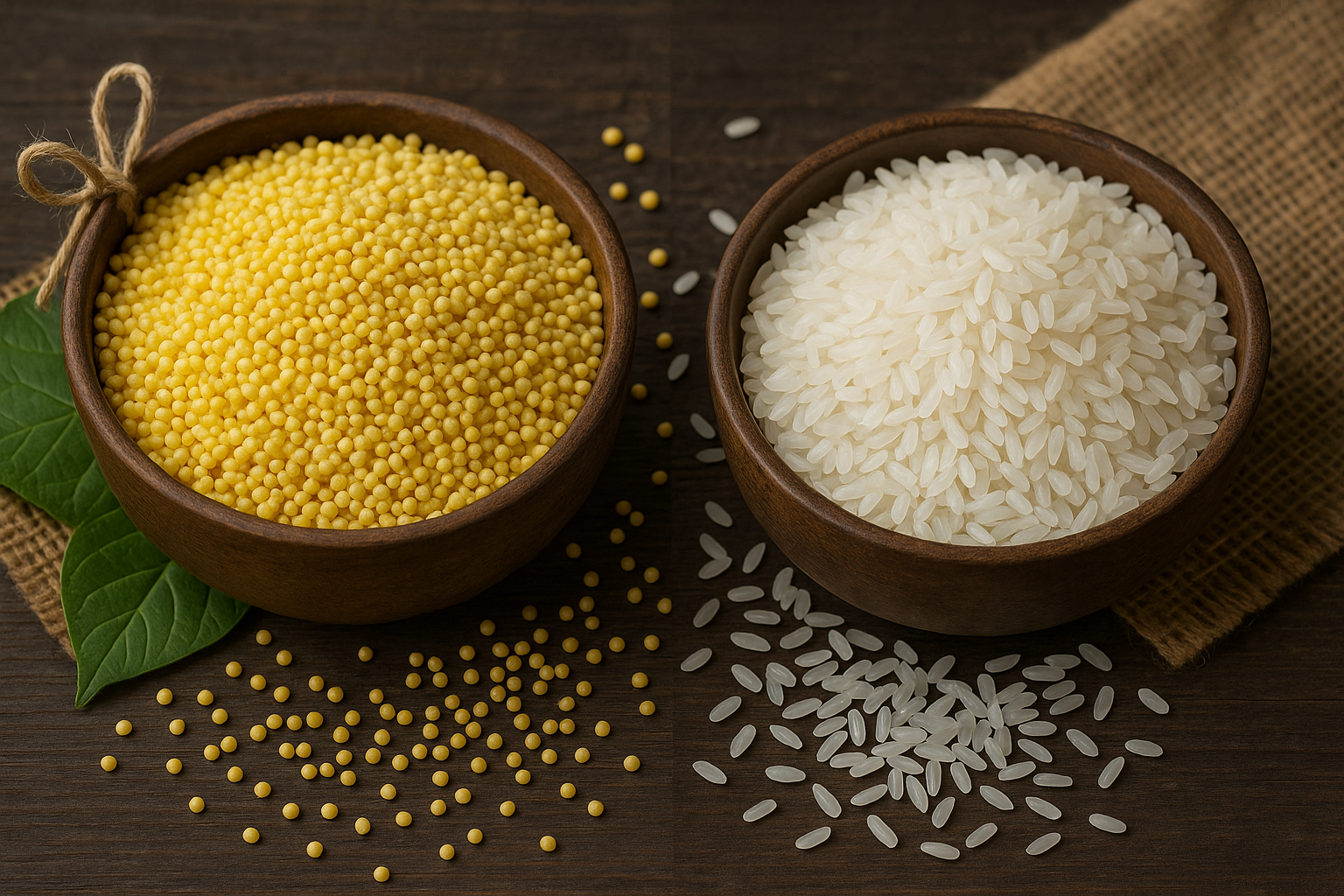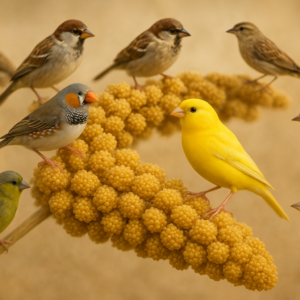The age-old debate between traditional grains continues to spark interest among health-conscious eaters. If you’ve been wondering whether to swap your daily bowl of white rice for yellow millet, you’re not alone. This comparison breaks down the nutritional differences, health benefits, and practical considerations to help you make an informed choice.
Understanding Yellow Millet and White Rice
Before diving into the nutritional showdown, let’s clarify what we’re comparing.
Yellow millet refers to several varieties of small-seeded grains, with pearl millet being the most common. These golden grains have sustained populations across Asia and Africa for thousands of years. Millet cultivation dates back approximately 10,000 years, making it one of the first grains cultivated by humans.
White rice, on the other hand, is rice that has been processed to remove the outer bran and germ layers, leaving only the starchy endosperm. When white rice is processed, the bran and germ are stripped away, making it less nutrient-dense than whole grain varieties. This processing gives rice its distinctive white appearance and softer texture.
CMS Industries, a leading agricultural products manufacturer and exporter in India, works with farmers across the country who grow both these grains, recognizing the diverse nutritional needs of global markets.
Nutritional Face-Off: Yellow Millet Vs White Rice
Let’s break down how these two grains stack up nutritionally.
Glycemic Index: The Blood Sugar Factor
The glycemic index (GI) measures how quickly foods raise blood sugar levels. This becomes particularly important for people managing diabetes or watching their weight.
Millets have a low glycemic index and are gluten-free, making them suitable for blood sugar management. In contrast, white rice has a high glycemic index in the range of 73, while brown rice scores around 68. The variety matters too: long-grain white rice has a glycemic index of 56, which is lower than some short-grain varieties.
What does this mean for you? Yellow millet causes a slower, steadier rise in blood sugar, providing sustained energy without the spike-and-crash cycle that high-GI foods can trigger.
Protein Content: Building Blocks for Your Body
Millets provide more essential amino acids than most other cereals, making them valuable protein sources. A cup of cooked millet delivers over 6 grams of protein, while white rice provides about 4.3 grams per cup.
The protein in millet includes all the building blocks your body needs, which is particularly beneficial if you follow a plant-based diet.
Fiber: The Digestive Health Champion
Here’s where yellow millet really shines. Millets are full of soluble fiber, which traps fat in your gut and can lower cholesterol levels in your blood. White rice is low in fiber compared to whole grain alternatives, which can lead to digestive problems.
The fiber in millet keeps you feeling full longer, supports healthy digestion, and feeds the beneficial bacteria in your gut. If you struggle with frequent hunger or digestive issues, this difference could be significant.
Vitamins and Minerals: Micronutrient Powerhouses
Yellow pearl millets are particularly rich in retinol (Vitamin A) and contain high levels of iron, zinc, and copper. Finger millet boasts the highest calcium content of all cereal grains, providing 13% of the daily value per cooked cup.
White rice, especially enriched varieties, contains B vitamins like thiamine and niacin. Brown rice retains more nutrients than white rice, but standard white rice loses much of its nutritional value during processing.
Find out which Pulses Are Best for a High-Protein Diet to boost your nutrition and fitness — please read this blog!
Health Benefits: Yellow Millet Vs White Rice
Blood Sugar Management and Diabetes Prevention
Millets contain fiber and non-starch polysaccharides that don’t digest easily in the gut, preventing blood sugar spikes and making them a good option for weight loss. Research consistently shows that millet consumption helps regulate blood sugar better than white rice.
For people with type 2 diabetes or those at risk, swapping white rice for millet could make a meaningful difference. Eating white rice is linked to a higher risk of developing type 2 diabetes, while eating brown rice is linked to a lower risk. Millet offers similar protective benefits.
Weight Management Support
Both grains can fit into a healthy diet, but millet has advantages for weight management. The combination of higher fiber content, lower glycemic index, and greater protein density helps you stay satisfied longer.
The glycemic index of millets is low, making them a good option for weight loss. The fiber slows digestion, reducing the likelihood of overeating and unnecessary snacking between meals.
Heart Health Considerations
Millets are good sources of magnesium, which may prevent heart failure and help maintain a healthy heart. The soluble fiber in millet also helps lower cholesterol levels, reducing the risk of heart disease.
White rice doesn’t offer the same cardiovascular benefits. While it provides quick energy and is easy to digest, it lacks the protective compounds found in whole grains and millets.
Gluten-Free and Digestive Benefits
Both yellow millet and white rice are naturally gluten-free, making them safe choices for people with celiac disease or gluten sensitivity. Millets are gluten-free and contain phytochemicals that aid in correction of lifestyle disorders and prevention of ailments like carcinogenesis.
The higher fiber content in millet supports digestive health by promoting regular bowel movements and feeding beneficial gut bacteria. Millet contains prebiotics, which stimulate the growth of probiotics within the microbiome, supporting gut health and the immune system.
Potential Drawbacks to Consider
Antinutrients in Millet
Millet contains compounds known as antinutrients that block the absorption of certain nutrients, including phytates and goitrogenic polyphenols. These compounds can interfere with mineral absorption, particularly calcium, iron, and magnesium.
The good news? Soaking grains in water for several hours before cooking helps decrease phytic acid, improving nutrient absorption. Simple preparation methods can minimize these effects.
Arsenic in White Rice
Some types of white rice may contain high levels of arsenic, a toxic substance that can increase the risk of cancer and other health problems. Rice absorbs arsenic more readily from soil and water than other crops.
Rinsing rice thoroughly before cooking and using extra water can help reduce arsenic content.
Taste and Texture Preferences
White rice has a mild flavor and soft texture that many people find comforting and familiar. Millet has a slightly nuttier taste and firmer texture, which may take some adjustment if you’re used to rice.
Toasting millet in a saucepan for a few minutes before cooking enhances its nuttier flavor. Experimenting with different cooking methods can help you find your preferred preparation.
Making the Switch: Practical Tips
Cooking Yellow Millet
To cook millet, combine 2 cups of water and 1 cup of millet in a medium saucepan, bring to a boil, then reduce heat and simmer with a lid for about 15 minutes until the millet absorbs most of the water. Remove from heat and let it sit covered for 10 minutes.
Millet works well in:
- Breakfast porridge with fruits and nuts
- Grain bowls with roasted vegetables
- Pilaf as a rice substitute
- Baked goods using millet flour
- Salads for added texture and nutrition
Preparing White Rice for Better Nutrition
If you’re not ready to give up rice completely, you can reduce its glycemic impact:
When rice is cooled overnight after cooking, some starch content converts into resistant starch, which resists digestion like fiber and lowers the glycemic response. Reheating leftover cold rice may even increase resistant starch content and produce a lower glycemic response compared to freshly cooked rice.
Pairing rice with protein, healthy fats, and vegetables also helps moderate blood sugar spikes.
Finding Quality Grains
Whether you choose millet or rice, sourcing quality matters. CMS Industries supplies premium agricultural products including various grains to markets worldwide, working directly with farmers to ensure nutrition and quality standards are met.
The Verdict: Which Is Healthier?
Yellow millet emerges as the healthier choice for most people, particularly if you’re concerned about:
- Blood sugar management
- Weight control
- Heart health
- Getting more nutrients per serving
- Sustained energy throughout the day
Millets offer supplementary benefits including treatment of anemia and calcium deficiency, especially for pregnant women and young children.
White rice still has its place, especially for:
- Quick energy needs
- Easy digestion during illness
- Athletes requiring fast-acting carbohydrates
- Those who prefer familiar tastes and textures
The healthiest approach? Include both grains in your diet along with other whole grains like brown rice, quinoa, and oats. Variety ensures you get a broad spectrum of nutrients.
Integrating Both Grains Into Your Diet
You don’t need to choose one grain exclusively. Try these strategies:
- Start gradually: Replace one rice meal per week with millet. As you adjust to the taste and texture, increase the frequency.
- Mix them together: Combine cooked millet and rice in equal parts for a transition option that provides nutritional benefits while maintaining familiar flavors.
- Match grains to meals: Use millet for breakfast porridge and lunch bowls, and save rice for occasional dinner dishes.
- Experiment with varieties: CMS Industries and other agricultural suppliers offer different millet types (pearl, finger, foxtail) and rice varieties. Each has unique flavors and nutritional profiles worth exploring.
Understanding Your Individual Needs
Your ideal grain choice depends on your health goals, medical conditions, and lifestyle.
For people with diabetes or prediabetes, millet’s lower glycemic index provides better blood sugar control. For athletes needing quick energy, white rice might be more appropriate before or after intense workouts.
Those managing digestive issues may find white rice easier on the stomach during flare-ups, while millet supports long-term digestive health through its fiber content.
If you’re working toward weight loss, millet’s combination of fiber, protein, and low glycemic index makes it the better choice for feeling satisfied on fewer calories.
Final Thoughts
The Yellow Millet Vs White Rice debate doesn’t have a one-size-fits-all answer, but the evidence leans toward millet for most health goals. Its superior fiber content, lower glycemic index, higher protein levels, and rich micronutrient profile make it a nutritional powerhouse.
White rice still has value as an easily digestible, quick-energy source, but relying on it as your primary grain means missing out on nutrients your body needs.
The best approach combines variety: include millet regularly while occasionally enjoying rice when it fits your needs. Listen to your body, consider your health goals, and choose grains that support your wellbeing. Whether you source your grains from CMS Industries or your local market, prioritizing quality and variety in your diet sets the foundation for lasting health.
The Bigger Picture: Sustainability and Agriculture
Millets are climate resilient and can contribute to a healthier life and better world through economic usage of natural resources. They require less water and grow well in harsh conditions, making them environmentally sustainable choices.
As agricultural suppliers like CMS Industries work to meet global demand for diverse grains, understanding the nutritional and environmental benefits of different crops becomes increasingly important.
Frequently Asked Questions
Is yellow millet better than white rice for weight loss?
Yes, yellow millet is generally better for weight loss due to its higher fiber content and lower glycemic index. The fiber keeps you feeling full longer and helps prevent overeating. Millet also provides more protein per serving, which supports satiety and helps maintain muscle mass during weight loss.
Can people with diabetes eat yellow millet daily?
Yellow millet is an excellent choice for people with diabetes because of its low glycemic index and high fiber content. These properties help prevent blood sugar spikes and provide steady energy throughout the day. Pairing millet with vegetables and protein sources creates balanced meals that support blood sugar management.
Does yellow millet contain gluten like wheat?
No, yellow millet is completely gluten-free, making it safe for people with celiac disease or gluten sensitivity. Both millet and white rice are naturally gluten-free grains. This makes them excellent alternatives to wheat, barley, and rye for those who need to avoid gluten in their diet.
How should I prepare yellow millet to reduce antinutrients?
Soaking yellow millet in water for several hours before cooking helps reduce antinutrients like phytic acid, which can interfere with mineral absorption. Rinsing the grain thoroughly and toasting it briefly in a dry pan before cooking also enhances both nutrition and flavor without compromising the health benefits.
Can I completely replace white rice with yellow millet in my diet?
Yes, you can replace white rice with yellow millet in most recipes. Millet works well in pilafs, grain bowls, porridge, and as a side dish. The texture and flavor differ slightly from rice, so you may need to adjust seasonings and cooking methods. Starting with partial replacement helps your palate adjust gradually.





